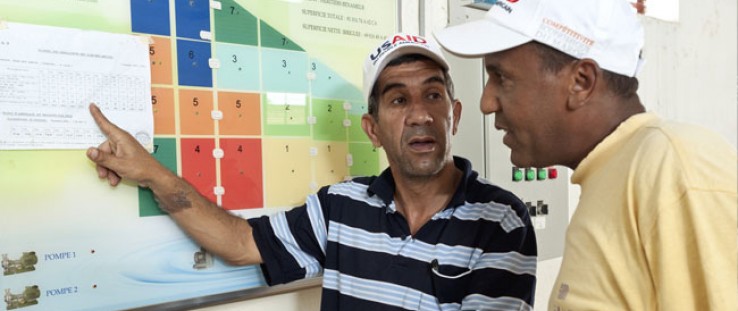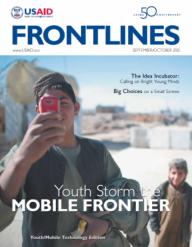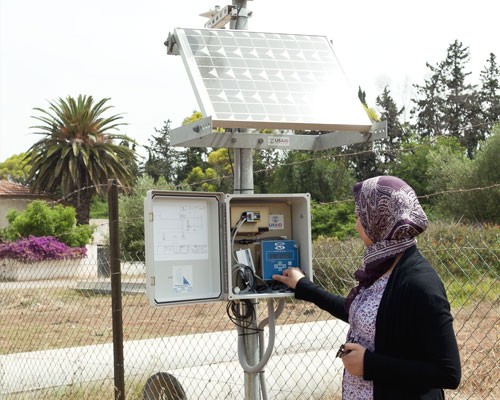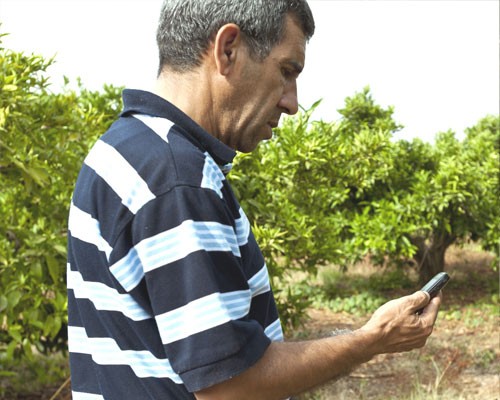 Mohammed Azzimani compares the irrigation guidance he receives from USAID with standard guidance.
Oussama Benbila/USAID
Mohammed Azzimani compares the irrigation guidance he receives from USAID with standard guidance.
Oussama Benbila/USAID
 Mohammed Azzimani compares the irrigation guidance he receives from USAID with standard guidance.
Oussama Benbila/USAID
Mohammed Azzimani compares the irrigation guidance he receives from USAID with standard guidance.
Oussama Benbila/USAID
Thursday April 5 Good morning in Berkane. Yesterday maximum temperature was 20 and minimum 9 degrees and rainfall was 0.0 mm. For citrus orchards, apply 25 cubic meters per hectare or 50 minutes if pump output 30 m3/hour/hectare.
For the first time in Morocco, messages like this, translated from French, are helping to shape good agriculture practices, popping up on the cell phones of a group of farmers each morning in a USAID pilot program. The new service—daily irrigation advice delivered to a mobile inbox—is already changing lives for the 500 early adopters in the eastern region of the North African country.
Mohammed Azzimani, a 52-year-old farmer in Berkane, now knows exactly how much to water his potatoes and tomatoes on a specific day.
“We live in a semi-arid land characterized by water scarcity. We are called upon at every occasion to use water wisely. Before, I didn’t know how much water I need to use for my potatoes and tomatoes. Now, I get a daily SMS telling me exactly the amount of water according to the weather condition,” he said.
The service, which was developed by the USAID Morocco Economic Competitiveness (MEC) program and launched in February 2011, is capitalizing on the recent exploding numbers of Moroccan households that own at least one mobile phone.
“While the service is not meant to replace important face-to-face agricultural assistance, text message delivery is without a doubt the most cost-efficient way to put relevant information into the hands of farmers on a daily basis,” said Fouad Rachidi, manager of the program’s agricultural activities.
The daily advisory service, which pulls information from automated weather stations that provide data to remote computers via mobile phone systems, promotes innovative irrigation techniques based on rainfall, temperature and evaporation rates to determine water requirements for specific crops.
It also directly complements the Moroccan Government’s broader initiative to conserve precious water throughout the country.
Changing Habits
Morocco, like much of North Africa, is semi-arid, but also heavily rural. In spite of the dearth of water, almost half of the population depends on agriculture to survive. According to Morocco’s Agricultural Development Agency, 70 percent of Moroccan farms cover less than 5 hectares (roughly the size of 11 American football fields) and many are struggling to survive.
The Moroccan Government is planning on investing about $2 billion in agricultural development through 2023, including funding the transition to more efficient irrigation methods. The text alerts are just one part of a greater effort to promote agricultural best practices.
Related Content
Until recently, Morocco’s regional agricultural development agency delivered water to farmers using tours-d’eau (water days), scheduled roughly every three weeks, depending on the season. During these water days, farmers would receive a fixed amount of water and use the entire amount to flood their fields.
Now, instead of the water days, farmers are installing water storage basins and more efficient drip irrigation systems.
The Ministry of Agriculture is promoting conversion to drip irrigation in all of Morocco’s main agricultural areas. In the Oriental region, where USAID is piloting the text irrigation advisory service, agricultural water authorities have established more than 1,000 water storage basins. Government subsidies cover 80 percent of the cost of setting up a drip irrigation system, and for farms smaller than 5 hectares the subsidy can reach 100 percent.
“Drip irrigation is more efficient than other methods the farmers were using, but farmers still need to know how much water to use,” said Mustapha El Haiba, the program’s water resources specialist.
Depending on daily weather conditions, crop water requirements change from one day to the next. Some of those daily variations can be substantial.
El Haiba explained, “Farmers need to base their irrigation practices on current weather data and the specific needs of their crop during a given time in the growth cycle. The new SMS service meets that need.”
Automating Weather
Before the program, only one weather station was operating in the area. An operator had to be present every day to record manually the data on maximum and minimum temperatures, rainfall and other factors, and communicate the information to the regional office by phone, fax or radio. USAID supported the acquisition of three weather stations that record all these data automatically. Technicians can access the data remotely using the mobile phone network.
The previous day’s data are downloaded from the automated weather stations and a program computes water requirements for each individual crop. Then, because the database contains a wide array of information on each participating farmer’s individual crops and farms—including planting dates, type of irrigation and pump output—the program delivers specially tailored, crop-specific water needs to each farmer’s cell phone.
Says Omar Nejjari, a small-business owner who has been working with USAID to promote the service: “Farmers have been receptive to the irrigation advice and there is growing demand. Not only do the farmers save money because they use less water, but they also economize on the cost of energy for pumping water since less water is needed. Farmers also expect to see higher crop yields from drip irrigation following SMS recommendations because they can avoid stressing the crops during hot, dry weather and can optimize fertilizer application.”
Nordine Mahrach, the 35-year-old manager of the Tarifit farm in Moulouya, has been thrilled with the results of the service. He points out that, for the first time, he now “has concise guidance on the daily irrigation needs of the various crops based on weather conditions and the stage of growth.” He expects to see tangible benefits in the coming months when the crops are harvested.
“Farmers that follow our advice can reduce their water consumption by as much as 30 percent,” says Edgar Ariza-Niño, the program’s monitoring adviser. “Finding ways to save water is critical for Morocco, where climate change is projected to reduce overall water availability by 10 to 20 percent during the coming decades. We believe innovative initiatives [such as this] in conjunction with far-sighted agricultural development policies … will help Morocco prepare now for future challenges.”
Tough Calculations
Nonetheless, the pilot phase of the program has revealed a number of challenges. Farmers say that adjusting pumping time each day is more complicated than following the current same-time-every-day practice. Some find it difficult to convert the recommendations about cubic meters per hectare. The process involves multiplication by the number of hectares, division by the pump output, and additions to the initial water meter reading to arrive at the final stop reading.
To address this problem, training sessions and farm visits are being conducted by program staff and the Ministry of Agriculture’s field agents to help farmers estimate the hourly pump outflow with and without water meters. During the next couple of months, regional agricultural authorities and USAID program staff will monitor a group of farmers receiving text irrigation advice to determine whether irrigation water consumption behavior differs from that of farmers not getting text messages.











Comment
Make a general inquiry or suggest an improvement.